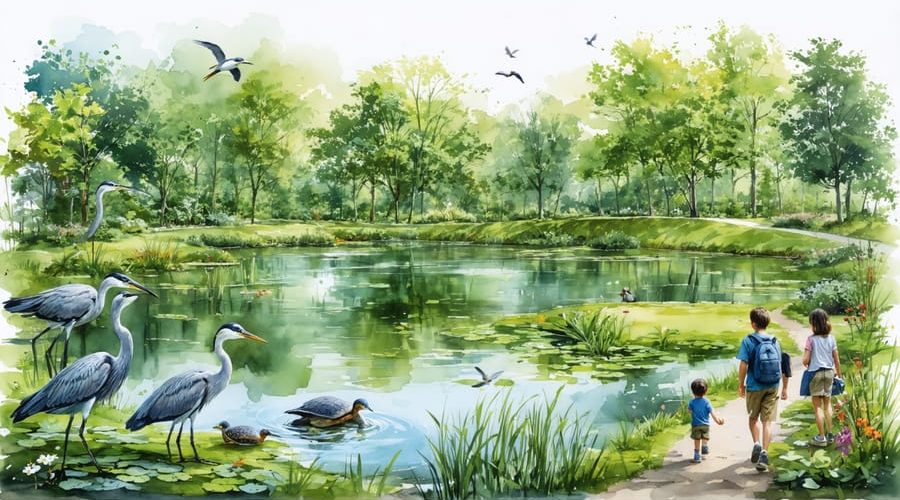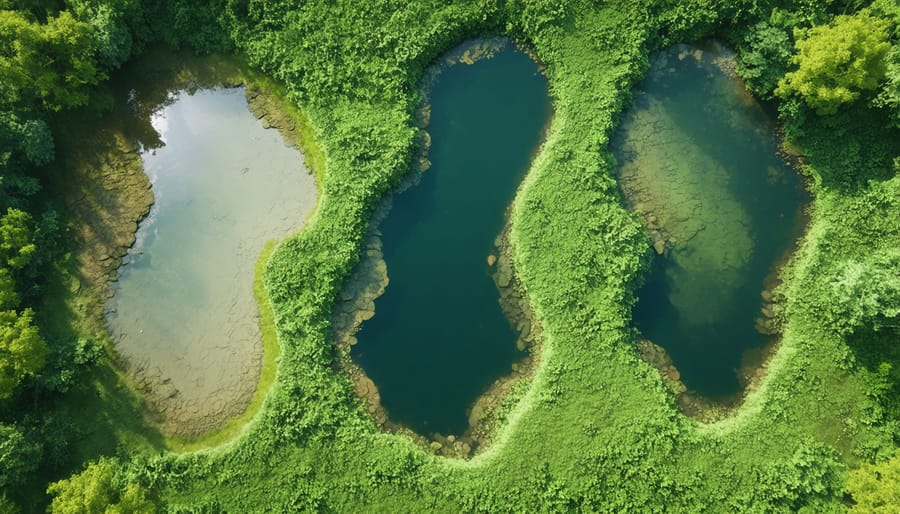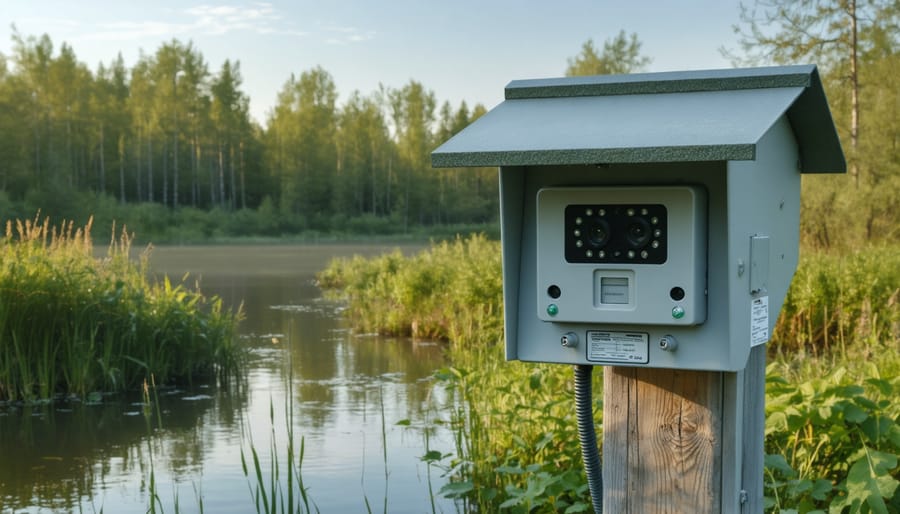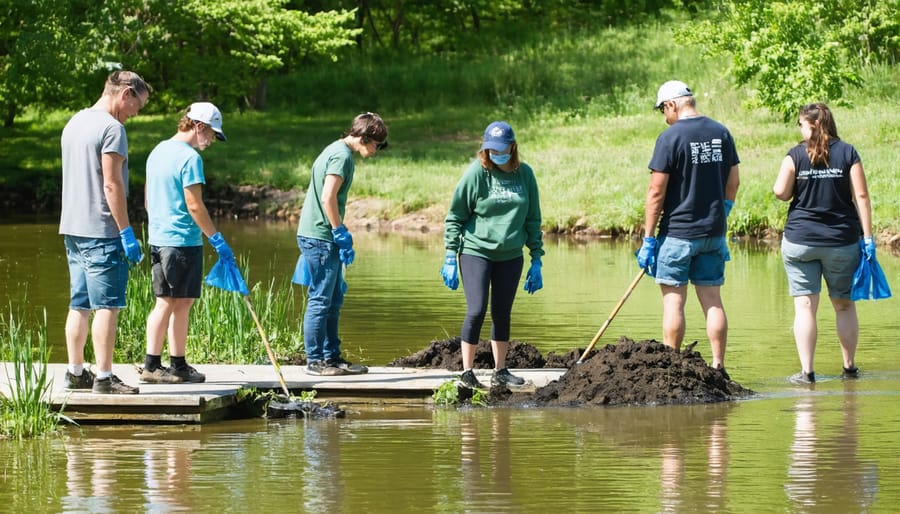
How 3 Ponds Park Transformed Wildlife Protection (A Local Success Story)
Nestled in the heart of nature’s embrace, Three Ponds Park stands as a testament to successful wildlife conservation and community stewardship. This 145-acre sanctuary showcases three pristine ponds, each supporting a diverse ecosystem of native flora and fauna. From great blue herons stalking the shallows to painted turtles basking on sun-warmed logs, the park serves as a crucial habitat for countless species while offering visitors an immersive natural experience.
The park’s innovative approach to ecosystem management combines state-of-the-art security measures with gentle human intervention, creating a delicate balance between public access and wildlife protection. Strategic trail design, motion-sensor cameras, and dedicated volunteer rangers work in harmony to preserve the park’s natural beauty while ensuring visitors can safely observe and learn from this living classroom.
As urbanization continues to challenge natural spaces, Three Ponds Park demonstrates how thoughtful conservation practices and community engagement can protect and enhance our precious water resources for future generations.

The Unique Ecosystem of 3 Ponds Park
Native Species and Their Habitats
The diverse ecosystem of 3 Ponds Park showcases a remarkable variety of native wildlife and plant species. The park’s three distinct ponds create perfect habitats for local aquatic life, making it an excellent example of maintaining natural pond ecosystems. Visitors can spot several species of waterfowl, including mallard ducks and great blue herons, which frequently visit the ponds for feeding and nesting.
The surrounding wetland areas support a thriving population of native amphibians, such as green frogs and spotted salamanders. Turtles, including painted and snapping varieties, can often be seen basking on logs or rocks around the pond edges. The park’s vegetation includes water lilies, cattails, and native rushes that provide essential cover for smaller wildlife.
Around the ponds, native flowering plants like purple coneflowers and black-eyed susans attract butterflies and beneficial insects. The wooded areas feature mature oak and maple trees, creating a sheltered environment for local songbirds and small mammals like squirrels and rabbits. This carefully preserved natural habitat serves as both a wildlife sanctuary and an educational resource for the community.
Interconnected Water Systems
The three ponds at 3 Ponds Park form a remarkable interconnected ecosystem that supports a diverse array of wildlife. Water flows naturally from the highest pond to the lowest through a series of gentle cascades and channels, creating different habitats along the way. The upper pond, being the deepest, provides a cool refuge for larger fish species and serves as a primary water source for the entire system.
The middle pond acts as a natural filtration system, with aquatic plants helping to purify the water as it moves through. This pond features shallow edges where wading birds like herons can hunt for small fish and amphibians. The lowest pond, rich in nutrients from the filtered water above, supports the most abundant plant life and attracts countless dragonflies, butterflies, and other beneficial insects.
During rainy seasons, the ponds work together to manage water flow, preventing flooding while maintaining consistent water levels throughout the system. This careful balance creates perfect conditions for local wildlife to thrive, from spawning fish to nesting waterfowl.
Innovative Security Measures
Wildlife Monitoring Systems
The 3 Ponds Park employs cutting-edge monitoring systems to ensure the safety and well-being of its diverse wildlife population. Motion-activated cameras strategically placed throughout the park capture valuable data about animal movements and behaviors, helping park managers implement effective wildlife protection strategies and maintain ecological balance.
Each pond area features underwater sensors that monitor water quality and fish population health in real-time. These smart systems alert park staff to any unusual changes in water temperature, oxygen levels, or pH balance that might affect aquatic life. Trail cameras equipped with night vision capabilities help track nocturnal animals and ensure their habitats remain undisturbed.
The park’s monitoring network includes acoustic sensors that detect and identify bird calls, helping ornithologists study migration patterns and breeding behaviors. Conservation efforts are supported by a sophisticated GPS tracking system for larger animals, providing insights into their territory ranges and feeding habits.
Local volunteers participate in regular wildlife counts and help maintain observation logs, creating a valuable database of animal activity. This community-driven approach to monitoring combines traditional observation methods with modern technology, making 3 Ponds Park a model for sustainable wildlife management in urban green spaces.

Water Quality Protection
At 3 Ponds Park, water quality management is a top priority, with several innovative measures in place to maintain the health of these cherished waterways. Each pond features specially designed filtration systems that work around the clock to remove debris and maintain optimal water clarity. Regular water testing ensures pH levels, dissolved oxygen, and nutrient content remain within ideal ranges for aquatic life.
The park employs natural solutions like beneficial bacteria and aquatic plants to help filter pollutants and maintain ecological balance. Strategic placement of wetland plants along the shorelines acts as a natural buffer, preventing erosion and filtering runoff before it enters the ponds. These planted zones also provide essential habitat for local wildlife while improving water quality.
A unique feature of the park’s water protection strategy is its rain garden system, which captures and filters stormwater before it reaches the ponds. This helps reduce the impact of urban runoff and prevents harmful substances from entering the water system. Additionally, the park maintains strict guidelines about feeding waterfowl and disposing of waste to prevent excess nutrients from disturbing the ponds’ delicate ecosystem.
Monthly monitoring by certified water quality specialists ensures early detection of potential issues, allowing for prompt intervention when necessary. This proactive approach has helped create a thriving aquatic environment that supports diverse wildlife while providing a beautiful recreational space for visitors.
Community Involvement and Education

Volunteer Programs
At 3 Ponds Park, community involvement plays a vital role in maintaining and protecting our precious ecosystem. Our volunteer programs offer numerous ways for nature enthusiasts to contribute to the park’s preservation while learning about aquatic environments and wildlife.
The Park Stewards Program welcomes volunteers every weekend for activities like pond cleanup, invasive species removal, and native plant maintenance. During spring and summer months, our Pond Watch initiative enables citizen scientists to monitor water quality and document wildlife sightings.
Families can participate in our Junior Rangers program, where children learn about pond ecosystems while helping with simple maintenance tasks. We also host monthly educational workshops where volunteers can learn about pond management, wildlife protection, and sustainable gardening practices.
For those interested in wildlife protection, our Dawn Patrol group assists in monitoring nesting areas and reporting any concerns to park rangers. Corporate groups can join our Adopt-a-Pond program, committing to quarterly maintenance activities at their chosen pond.
To get involved, simply visit the park office or register through our online volunteer portal.
Educational Initiatives
At 3 Ponds Park, education comes alive through hands-on learning experiences designed for visitors of all ages. The park’s signature “Pond Explorers” program invites school groups and families to discover the fascinating world of aquatic ecosystems. Trained naturalists guide participants through interactive sessions where they can safely catch and identify pond creatures, learn about water quality testing, and understand the delicate balance of pond life.
During summer months, weekly “Junior Naturalist” workshops teach children about pond conservation, native plants, and local wildlife through fun activities and crafts. The park’s observation decks feature educational panels that explain the role of different pond zones and their inhabitants, making self-guided learning accessible year-round.
The park also partners with local schools for field trips, offering curriculum-aligned programs that combine science education with outdoor exploration. Monthly “Evening at the Pond” sessions allow visitors to experience nighttime pond activity while learning about nocturnal creatures and their adaptations. These educational initiatives help foster environmental awareness and create lasting connections between visitors and nature.
Future Conservation Plans
The future of 3 Ponds Park looks bright with several exciting conservation initiatives in development. Park management has unveiled a comprehensive five-year plan focusing on habitat restoration and wildlife protection. The cornerstone of this plan includes the creation of new wetland buffer zones around each pond, which will help filter runoff and provide additional nesting areas for local waterfowl.
Starting next spring, volunteers will begin planting native species of aquatic plants and installing floating islands to improve water quality and create more natural habitats. The park is also partnering with local schools to establish an environmental education program, where students can participate in hands-on learning about pond ecosystems and wildlife conservation.
A major upgrade to the park’s water management system is scheduled for completion by 2025. This includes installing smart monitoring devices to track water quality and wildlife movement patterns. The data collected will help inform future conservation decisions and ensure the long-term health of the park’s aquatic ecosystems.
Community involvement remains central to these efforts, with monthly volunteer days planned for trail maintenance and pond clean-up activities. The park board has also secured funding for a new visitor center, which will feature interactive exhibits about local wildlife and sustainable pond management practices.
Long-term protection strategies include establishing conservation easements to permanently protect the land from development and creating wildlife corridors connecting 3 Ponds Park to neighboring natural areas.
Three Ponds Park stands as a shining example of successful wildlife conservation and community engagement in urban green spaces. Through careful management and dedicated protection measures, the park has become a thriving sanctuary for diverse species, from migratory birds to native amphibians. The implementation of strategic security protocols, combined with educational programs, has created a balanced environment where visitors can enjoy nature while wildlife flourishes undisturbed.
The park’s success story demonstrates how urban spaces can effectively support biodiversity while providing recreational opportunities for the community. Regular monitoring shows increasing populations of protected species, and visitor feedback consistently highlights the positive impact of conservation efforts on their park experience. The preservation of natural water features and surrounding habitats has created a sustainable ecosystem that continues to attract new species each year.
Looking ahead, Three Ponds Park remains committed to its mission of wildlife protection while serving as an educational resource and peaceful retreat for visitors. Its achievement in balancing human activity with nature conservation serves as a model for similar urban parks nationwide.
